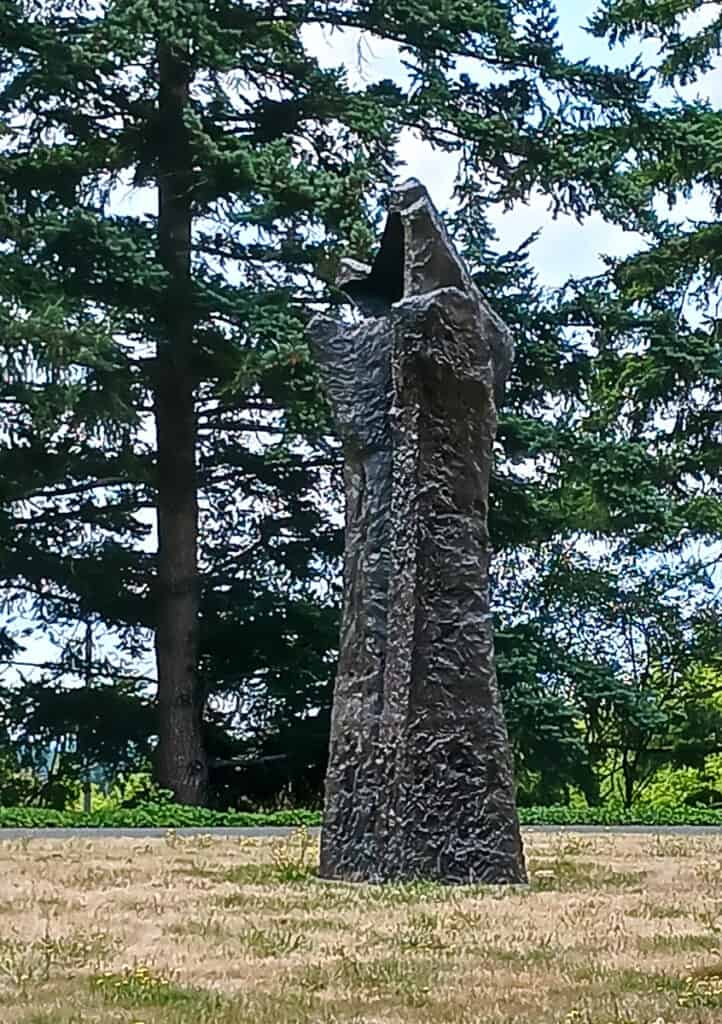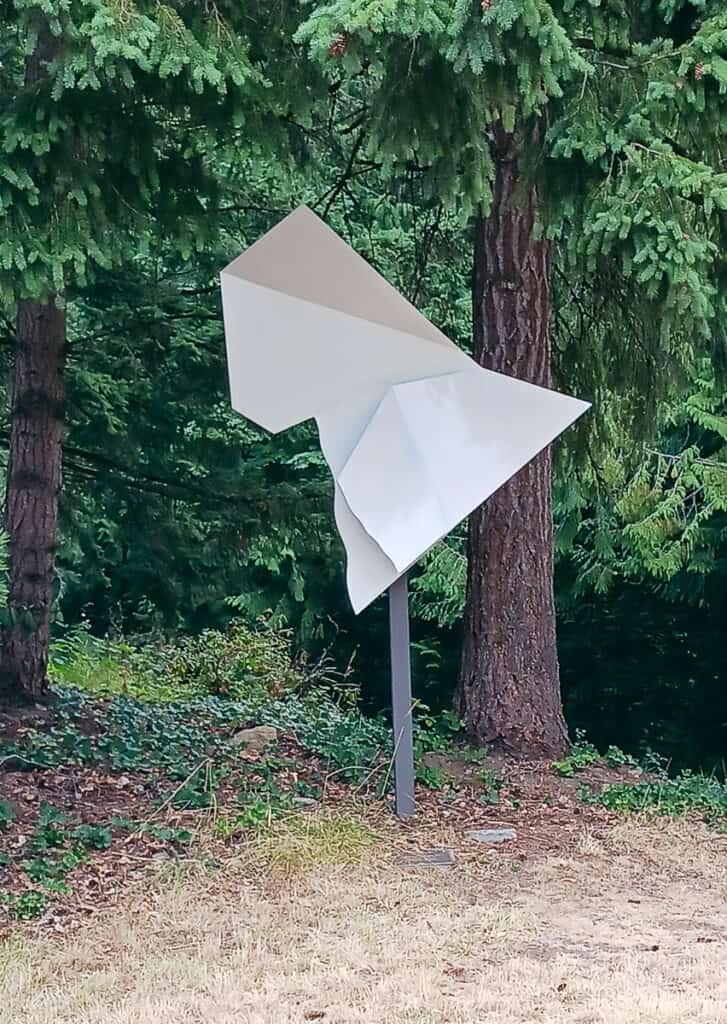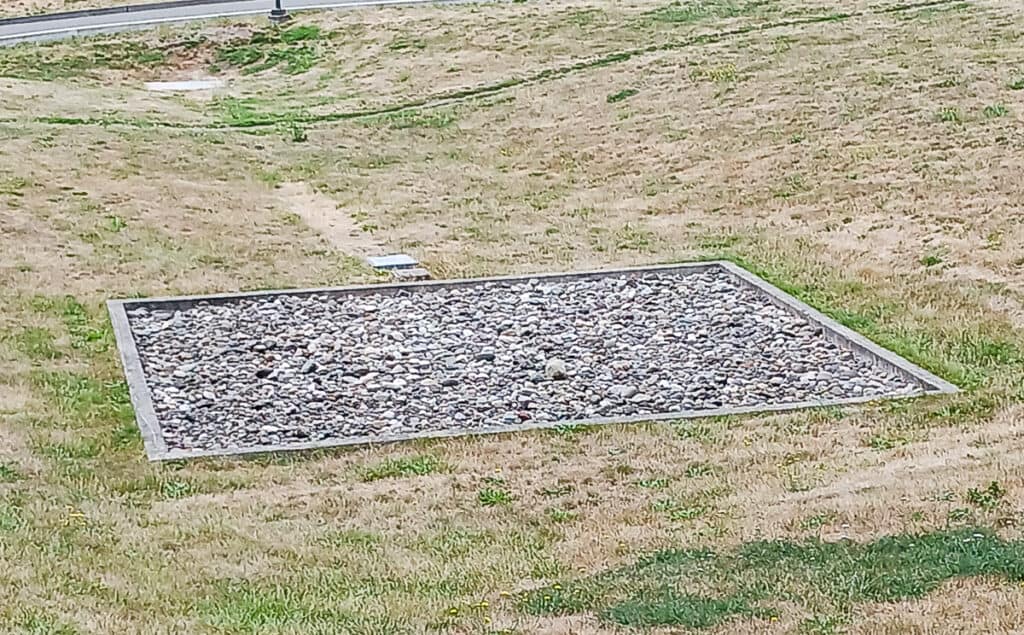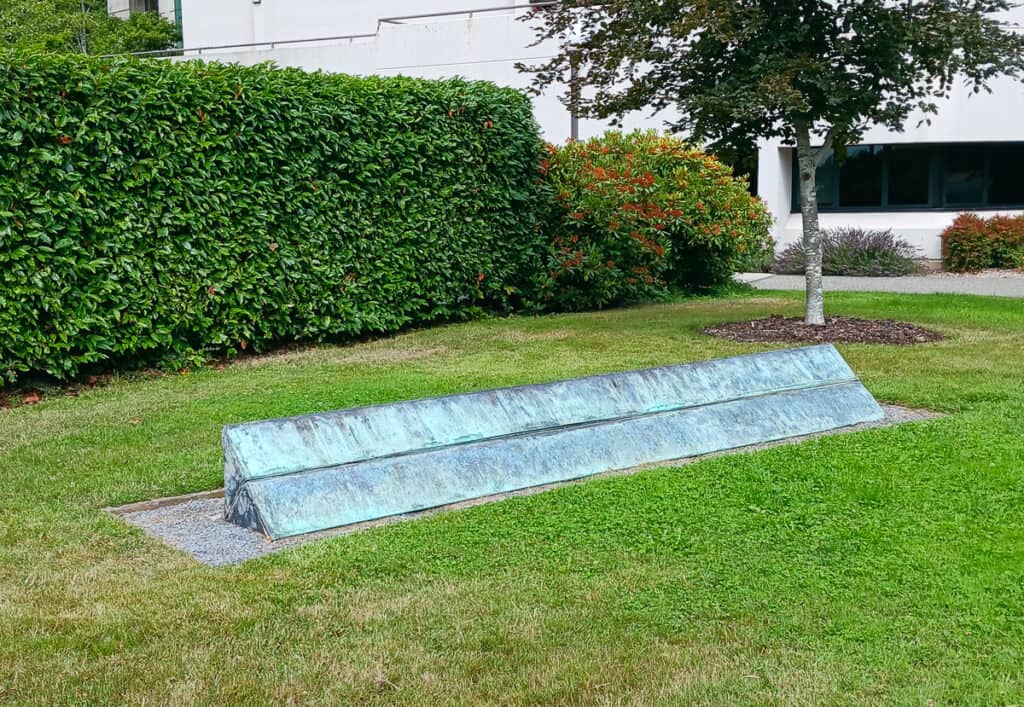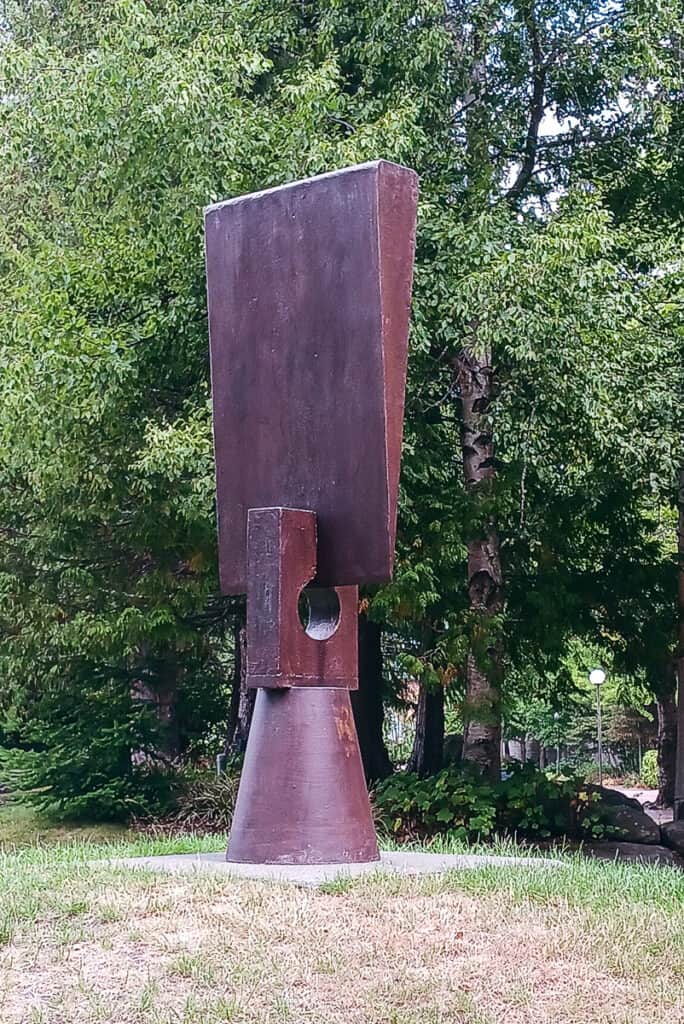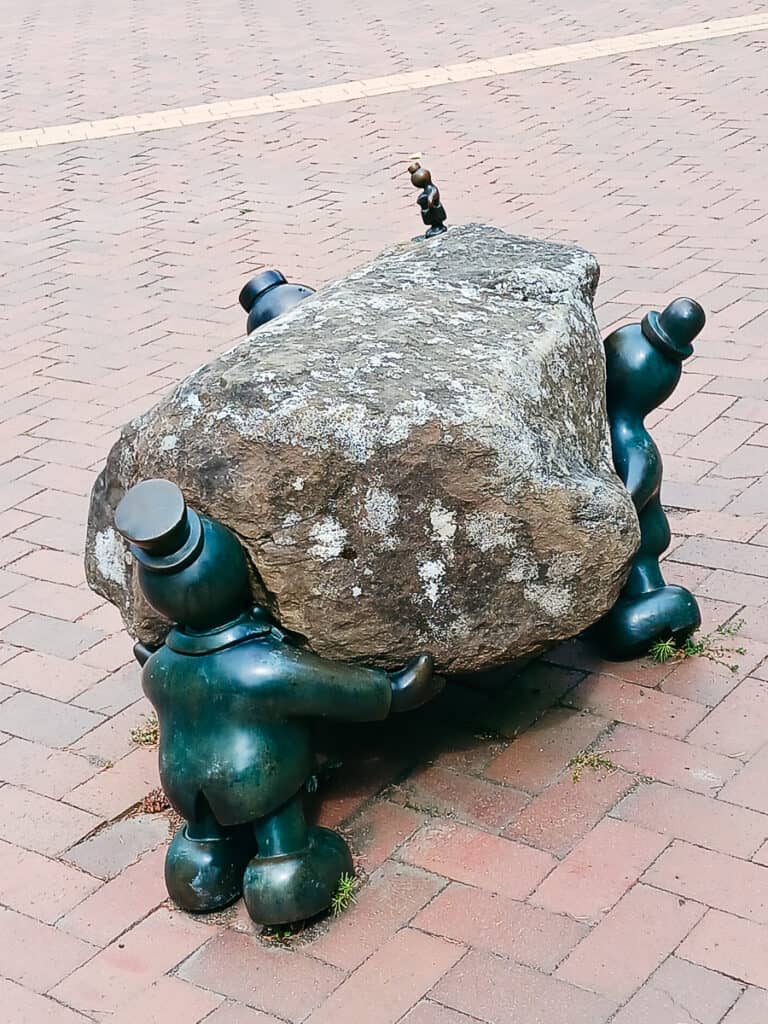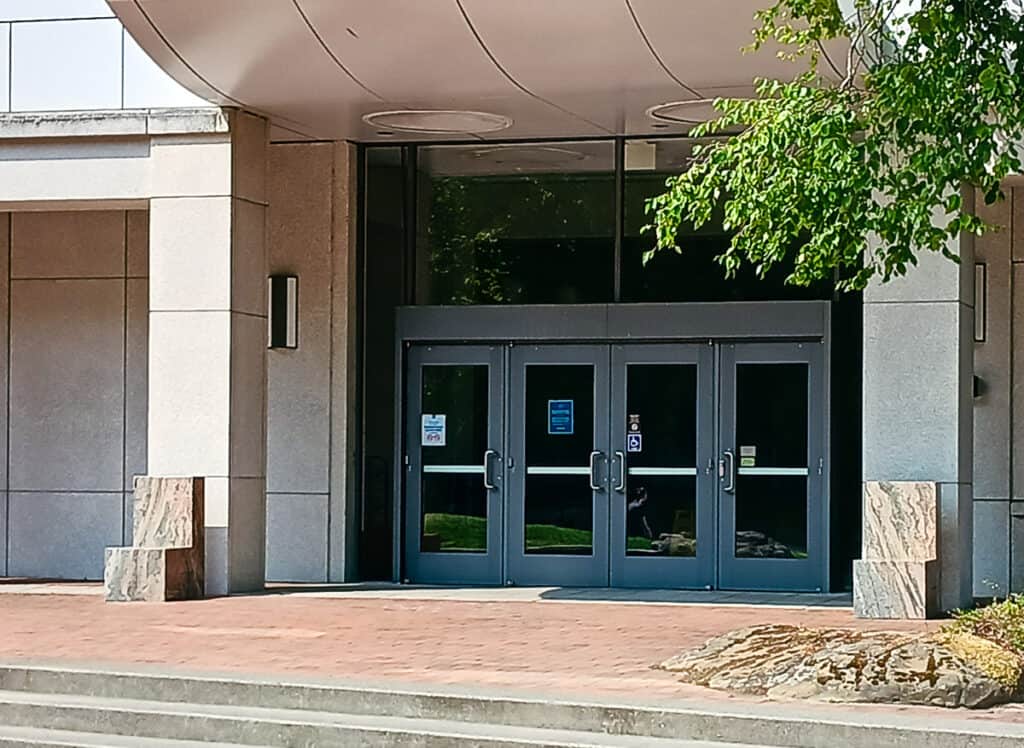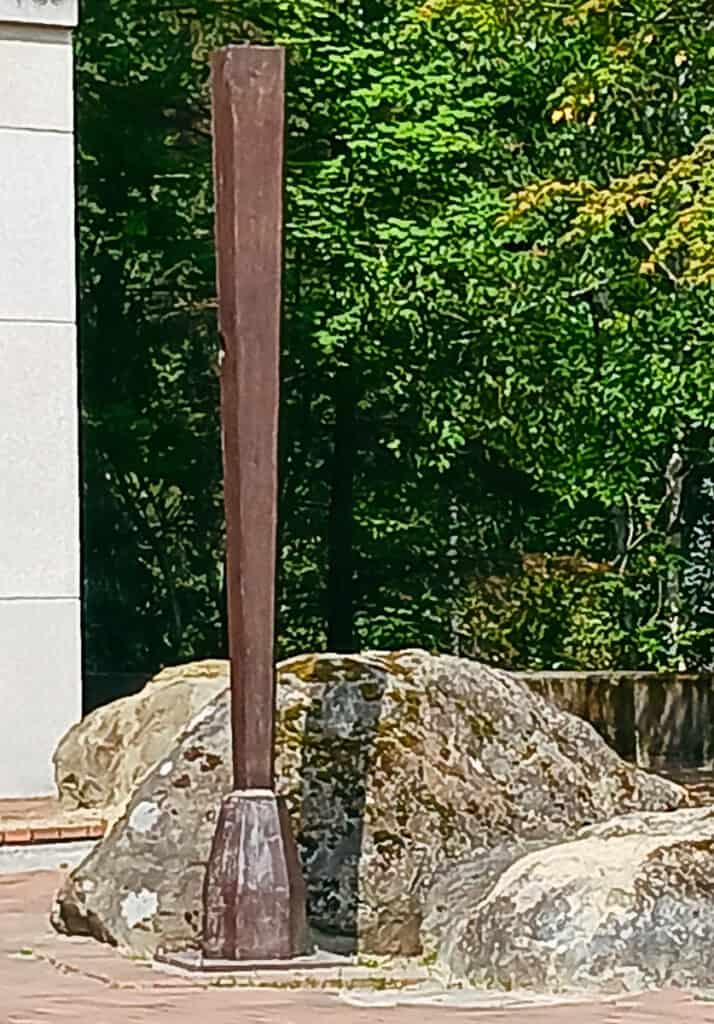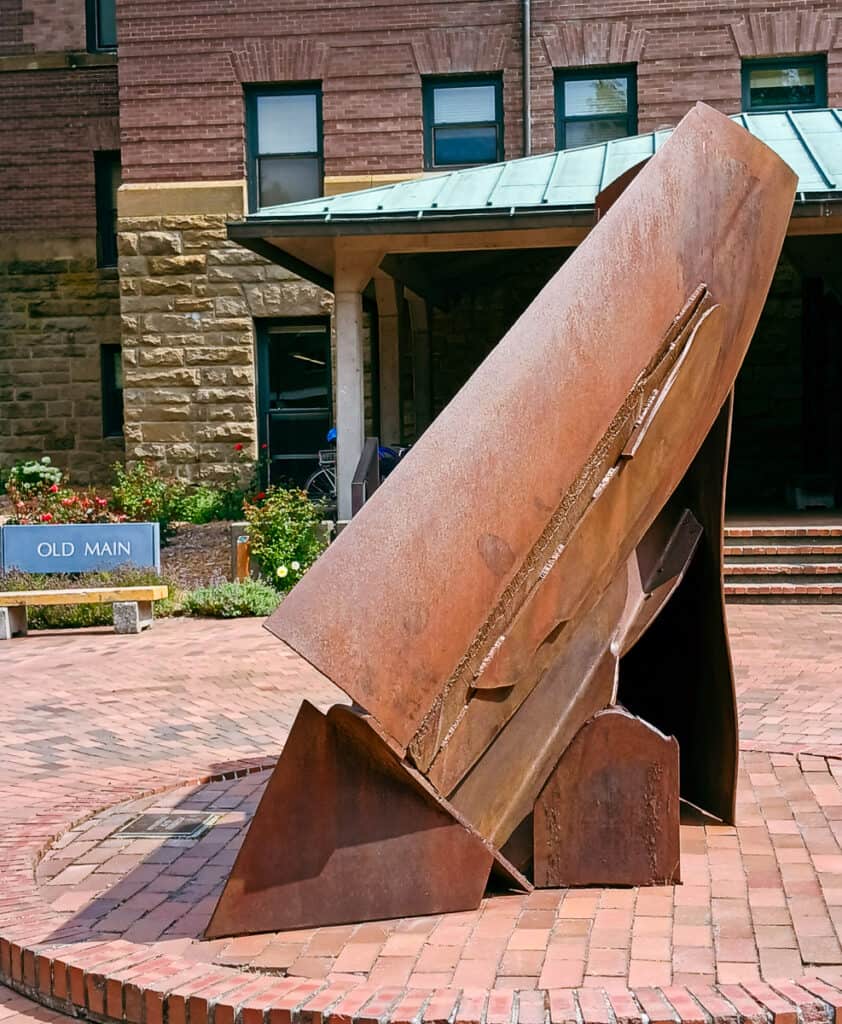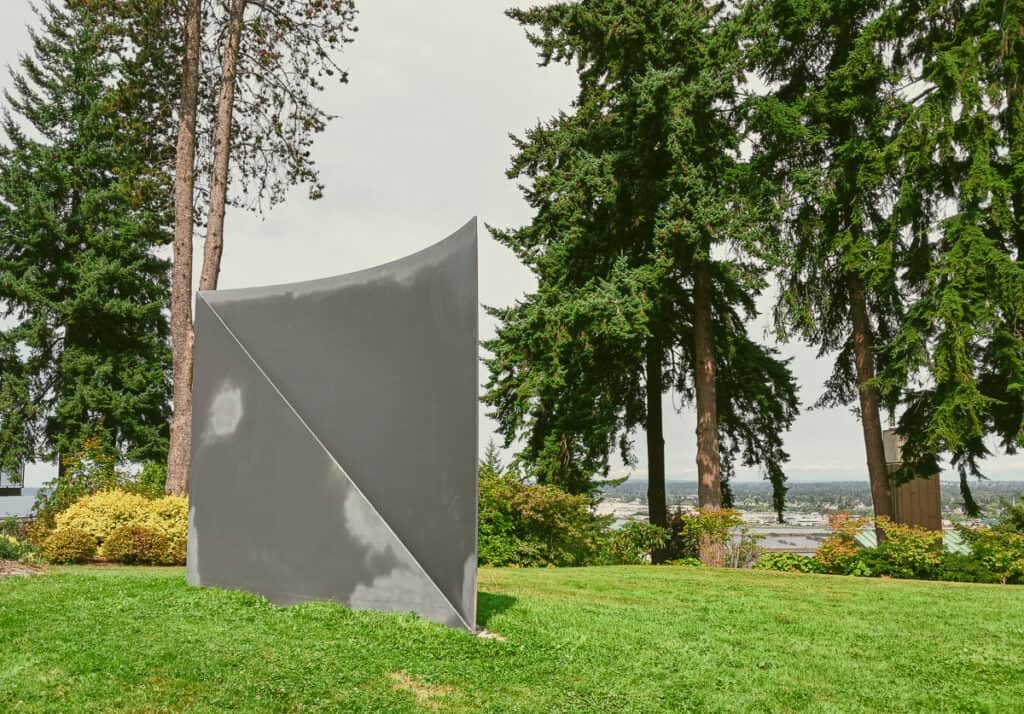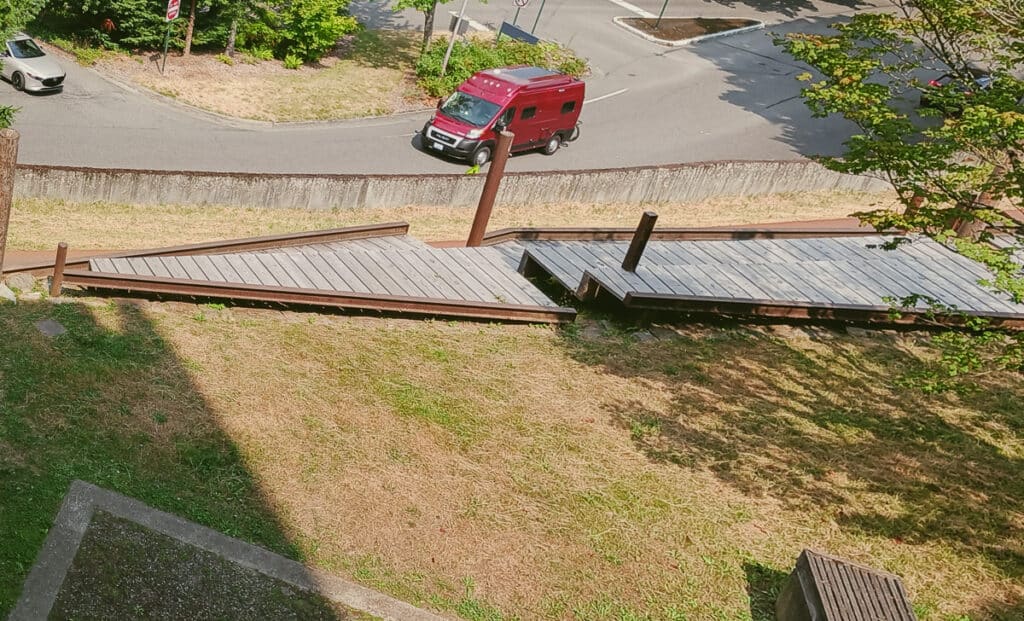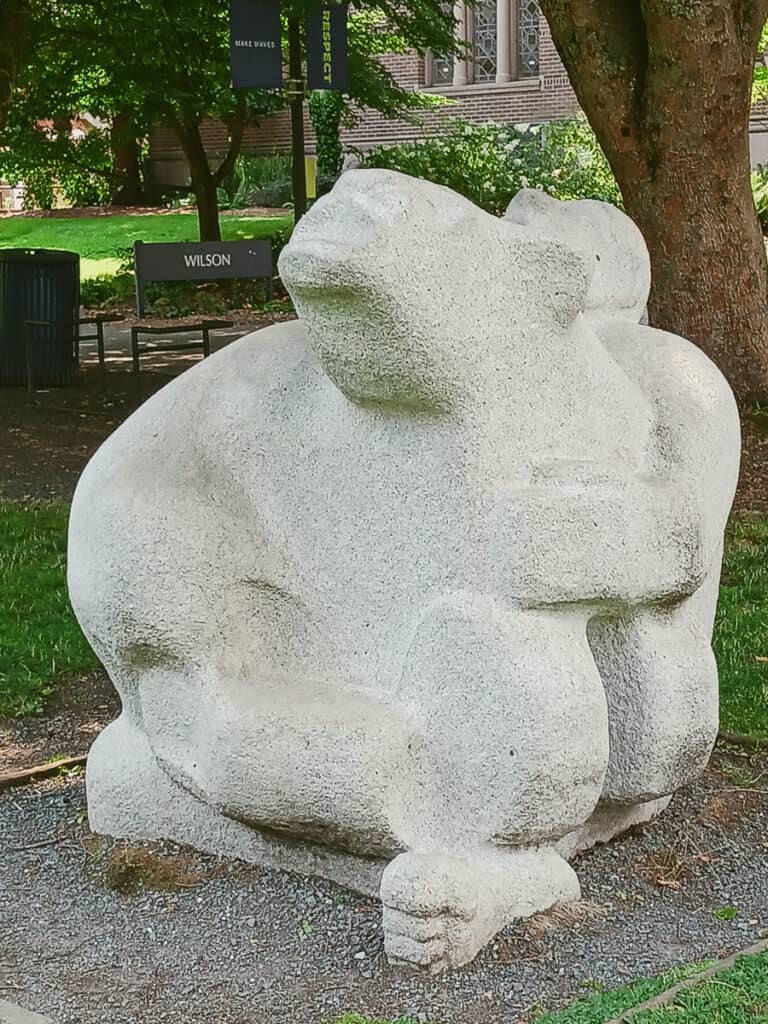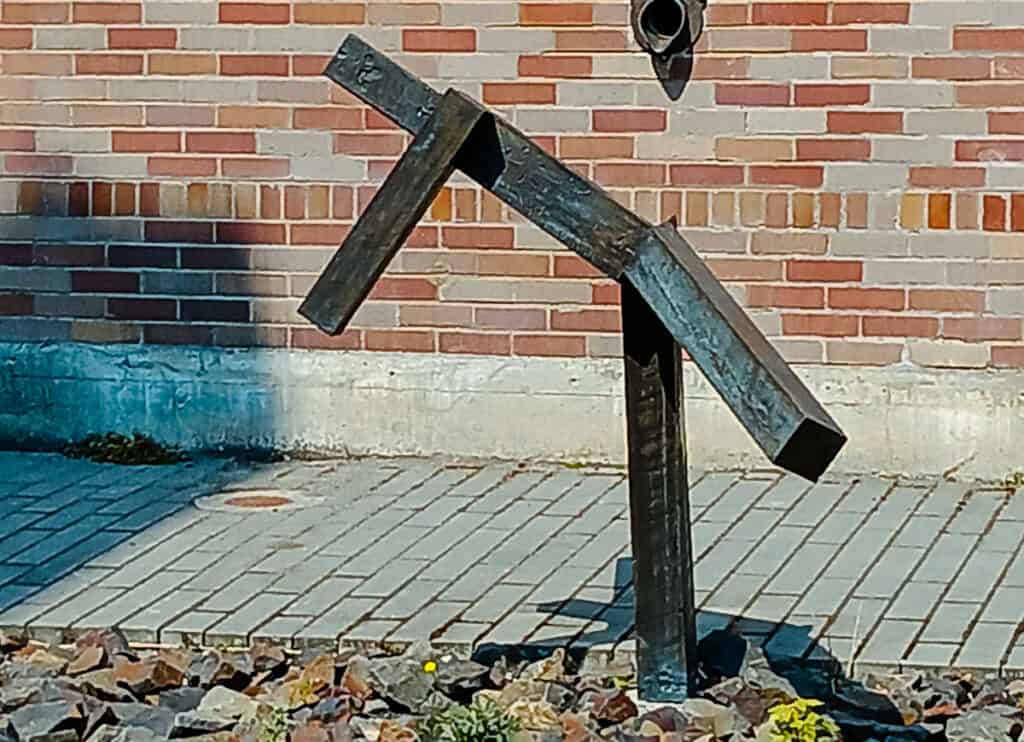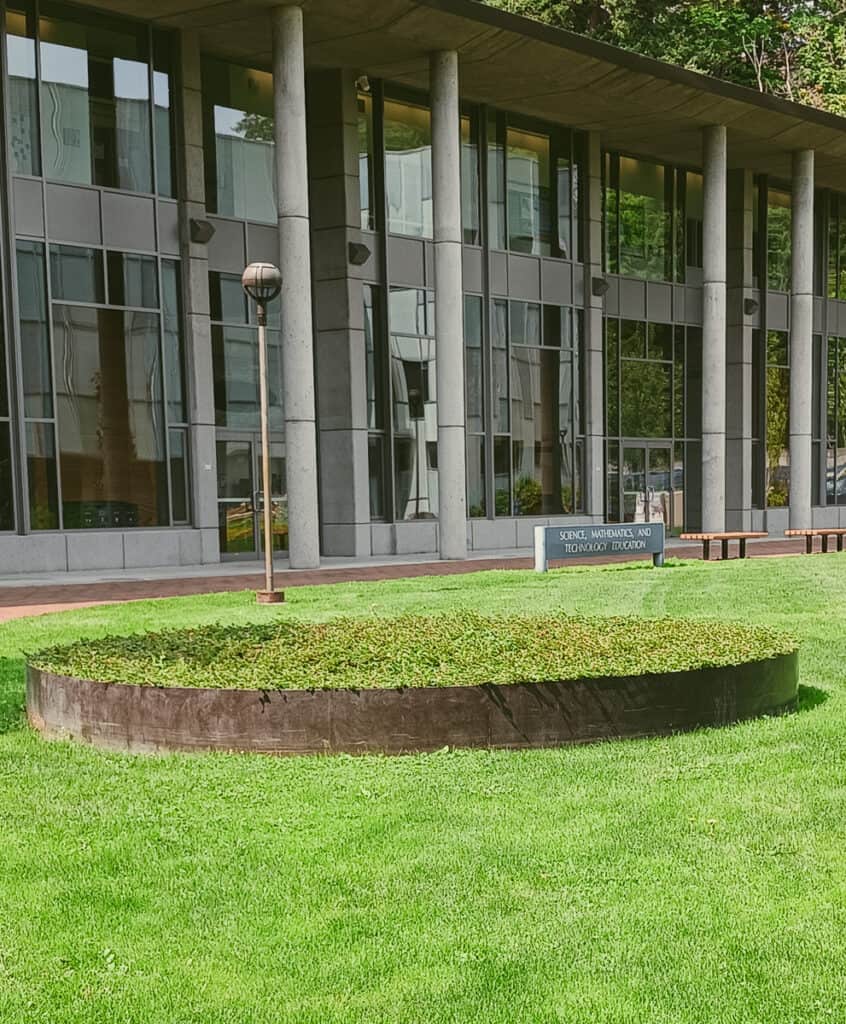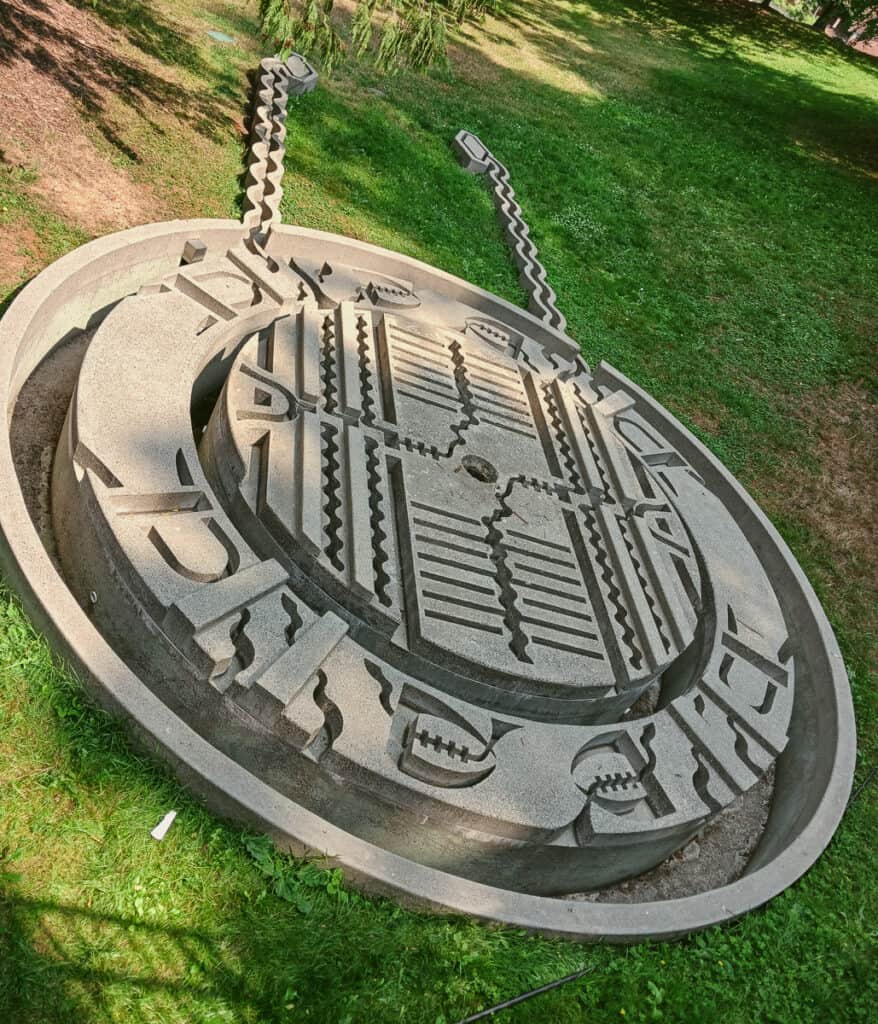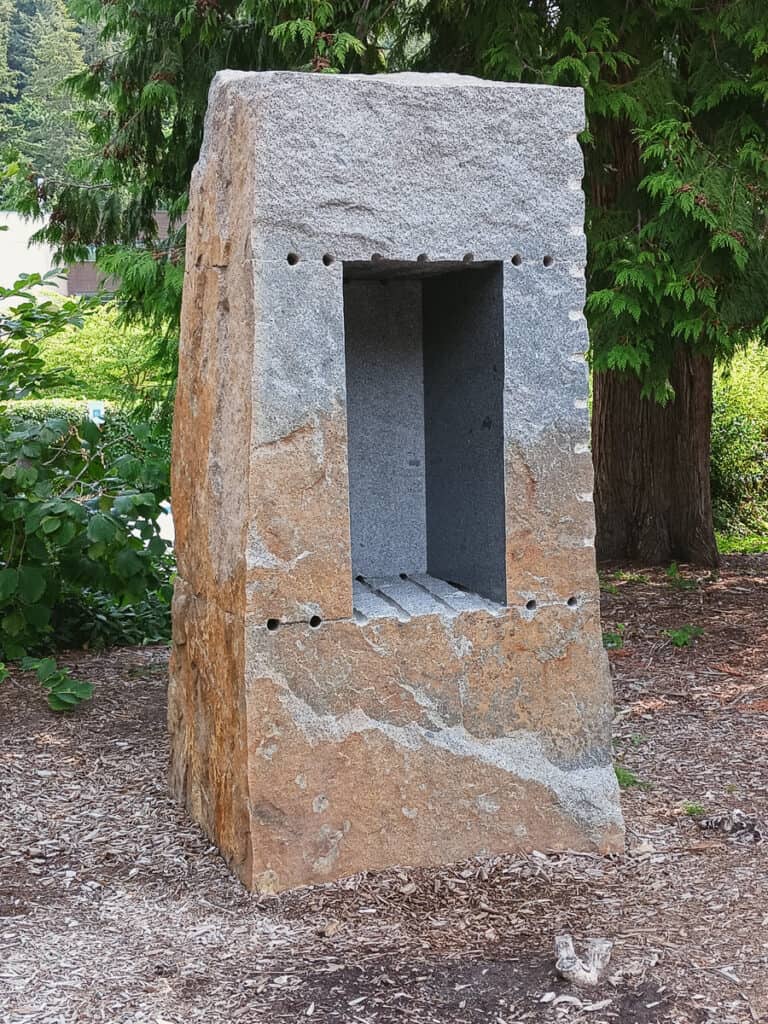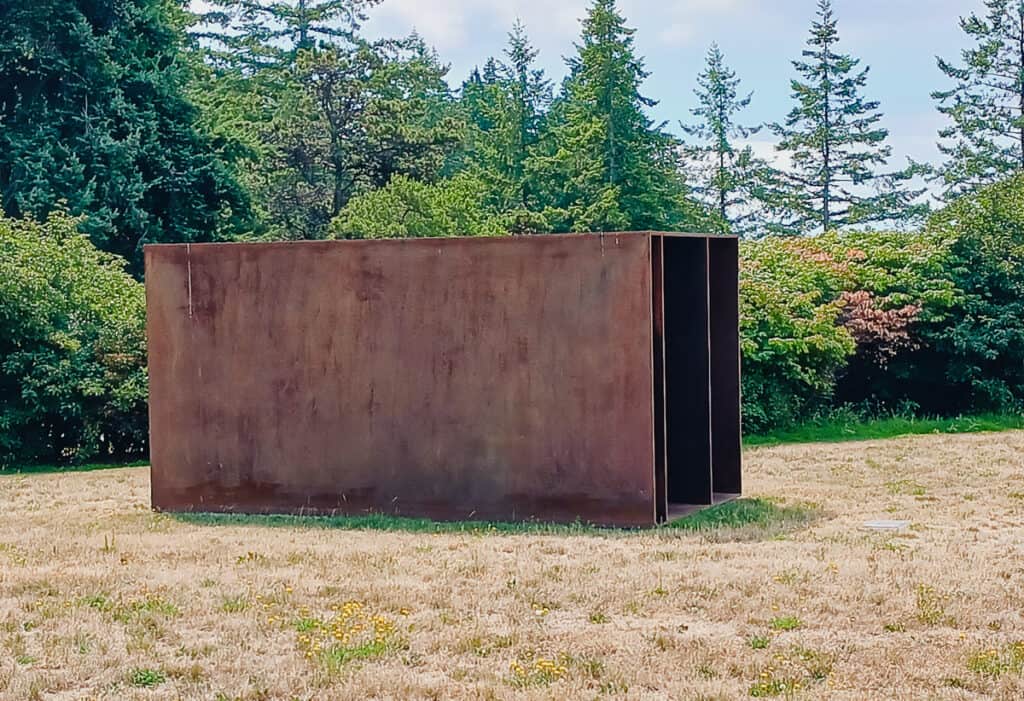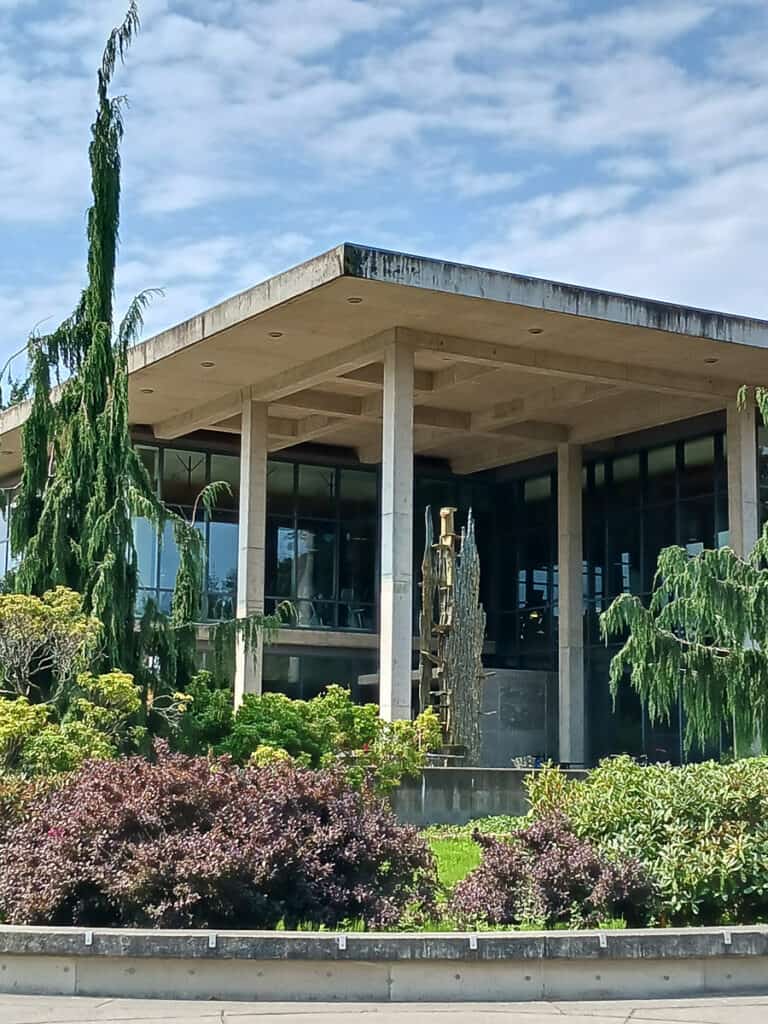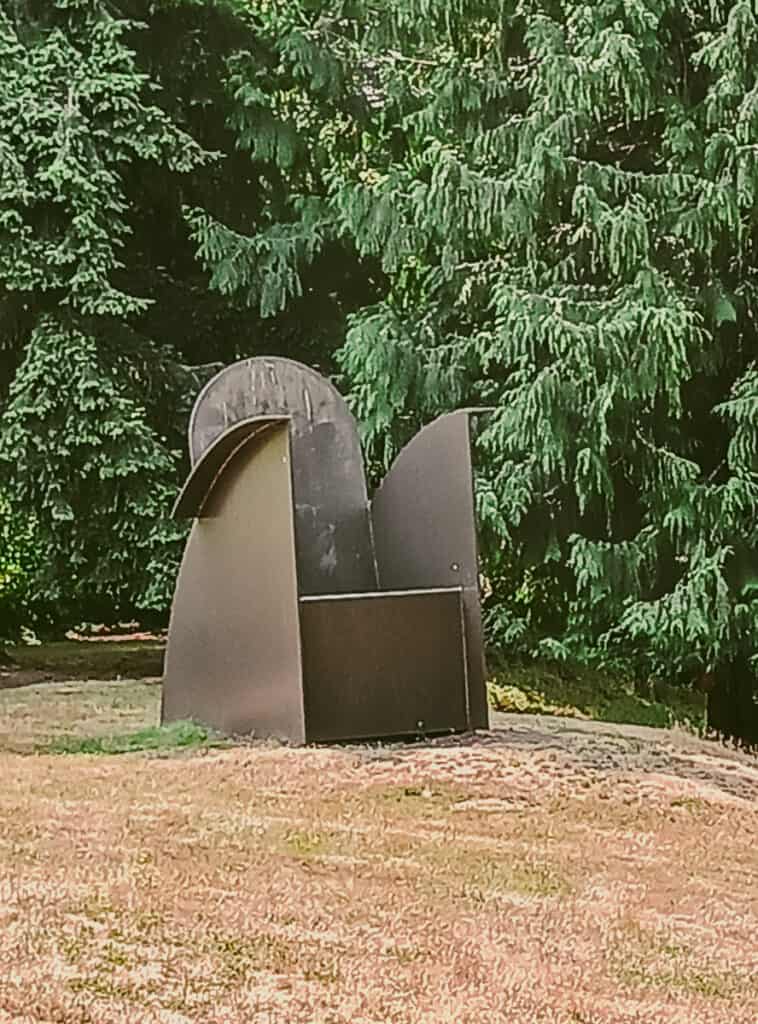Outdoor Sculptures at WWU: A Guide to Exploring Art on Campus
If you’re looking for a unique way to spend an afternoon, exploring the outdoor sculptures at Western Washington University is an excellent choice. The campus is home to a diverse collection of public art, including sculptures that range from abstract to representational (but mostly abstract).
The sculptures are located throughout the 220 acre campus. The campus itself is a work of art, with architecture ranging from the stately old red brick of Old Main and Red Square, to more brutalist structures on the southern end as well as 21st century buildings. Walking from north to south is almost a history lesson in architecture.
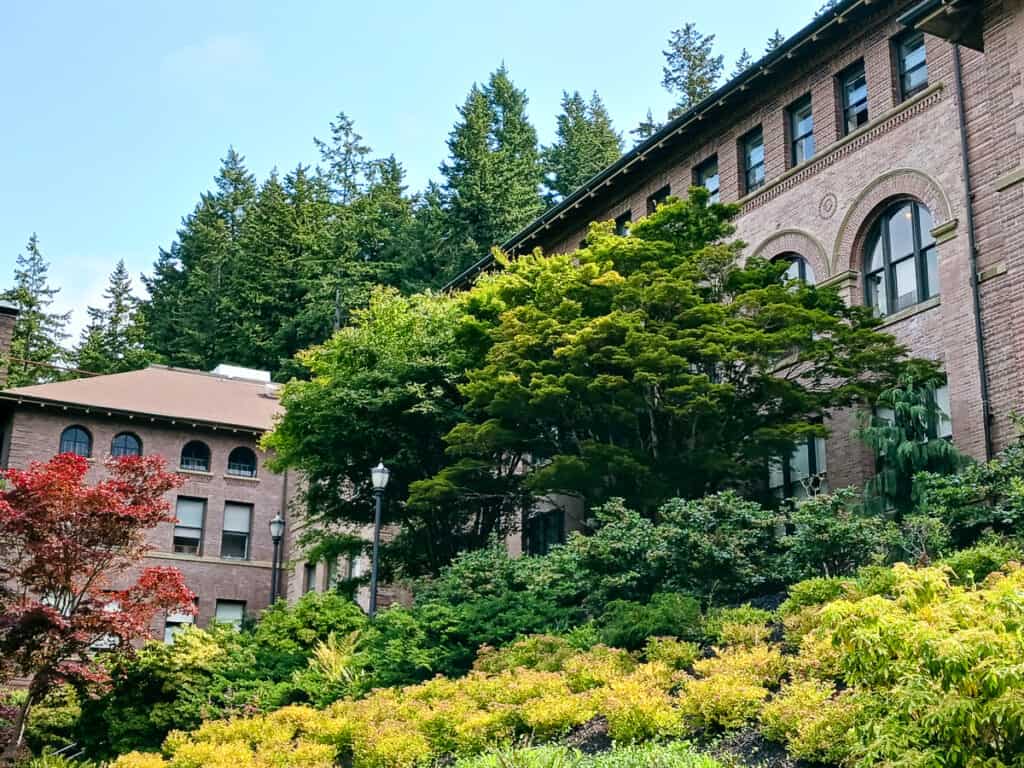
Nature has its say too. Set on a hilltop, the campus has stunning views of Bellingham Bay, the marina, and parts of downtown. The narrow strip of campus is flanked by evergreens on either side and plantings are found throughout campus.
The campus is especially beautiful from mid-spring through mid fall. In spring, trees are in bloom, in fall they are turning color. On a recent early August visit, the gardens were fully leafed out and thriving.
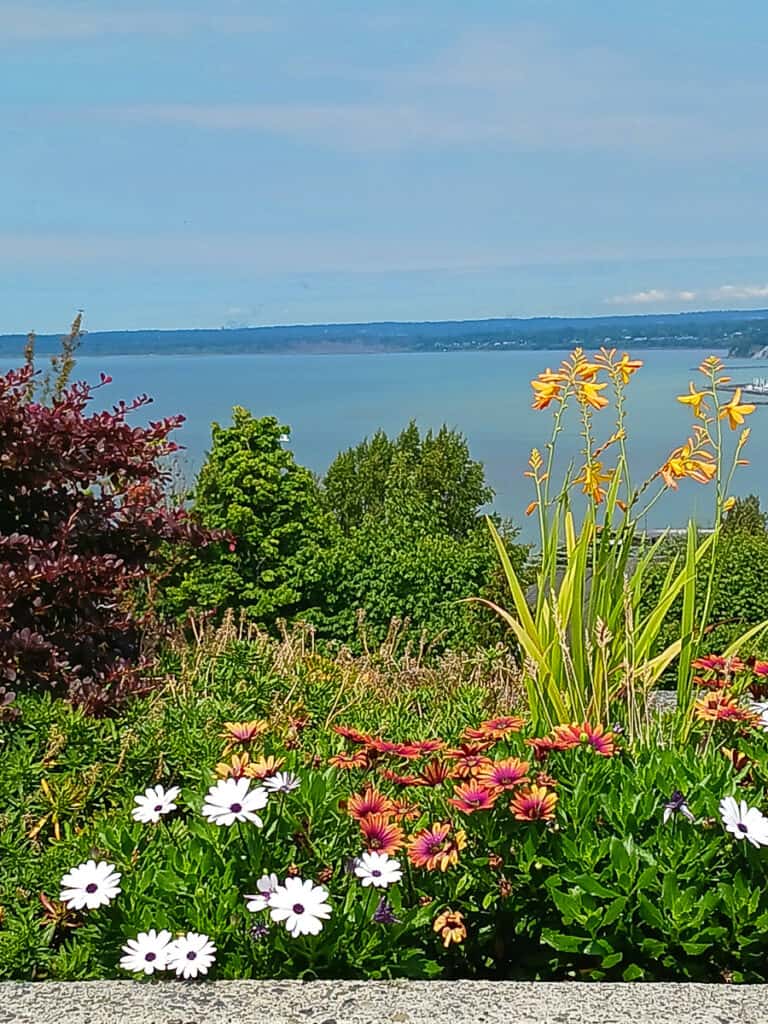
Tips if you’re taking a self guided tour
We started our walk near Fairhaven college, in the southeast corner of campus, proceeded north taking in all the art along the eastern buildings, and then returned past the library, gym and towards the visitors center before circling back to Fairhaven college to find one last sculpture.
I highly recommend downloading (and printing) the map for the self-guided sculpture tour in advance. Even with the map, there were one or two pieces we couldn’t locate. Conveniently, all of the outdoor sculptures are pink colored dots on the map.
Visiting is free, however if you drive you will have to pay for parking. Be prepared to use the paystations. Parking for visitors is limited during the academic year. WWU is on the quarter system and classes are in session from approximately mid-September to mid-June.
Parking information and maps can be downloaded here.
Overview of Outdoor Sculptures
Western Washington University’s outdoor sculpture collection is open to the public to enjoy any time. The collection includes works by distinguished contemporary American and European sculptors of the late 20th century to the present including Mark di Suvero, Richard Serra, and Isamu Noguchi.
Students and alumni alike will be familiar with notable works like:
- “For Handel” Mark di Suvero
- “Stadium Piece” Bruce Naumann
- “Stone Enclosure: Rock Rings” Nancy Holt
- “Log Ramps” Lloyd Hamrol
- “Wright’s Triangle” Richard Serra
- “Skyviewing Sculpture” Isamu Naguchi
The Western Gallery has pages on its site for each work, some with audio narration. Each provides an introduction to the work as well as insights from the artists themselves.
Guided tours are available for school groups and other large, organized groups. Contact the gallery for more information and to arrange a tour.
Highlights of the Outdoor Sculpture Collection
When visiting the Western Washington University Outdoor Sculpture Collection, there are a few sculptures that you simply can’t miss, both due to their size and their renown.
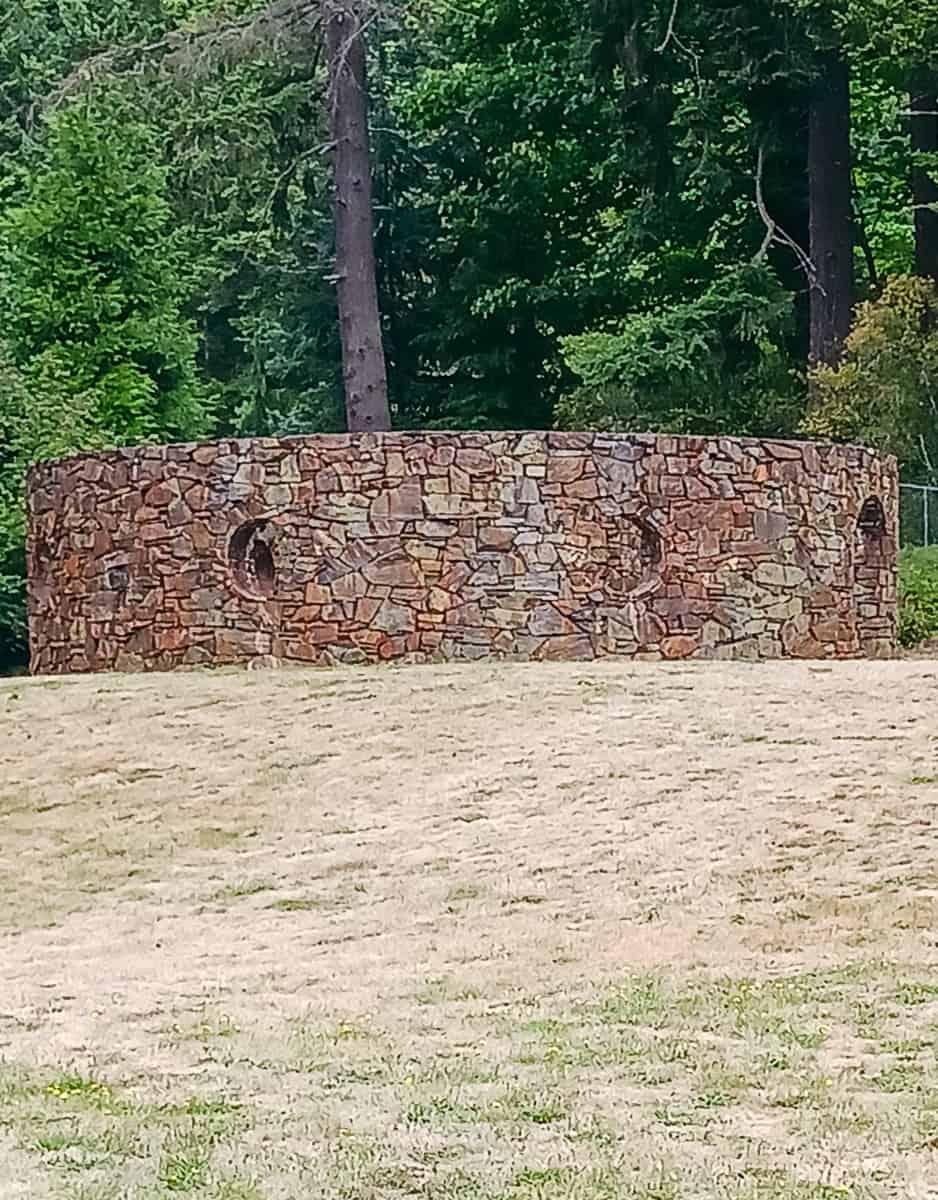
One of my favorite sculptures is the “Stone Enclosure: Rock Rings” by Nancy Holt. This sculpture is a collection of sepia colored rocks arranged in a circular pattern, creating an enclosure that visitors can walk through.
(August 2023: currently you cannot walk through Stone Enclosure as the area is fenced off for construction).
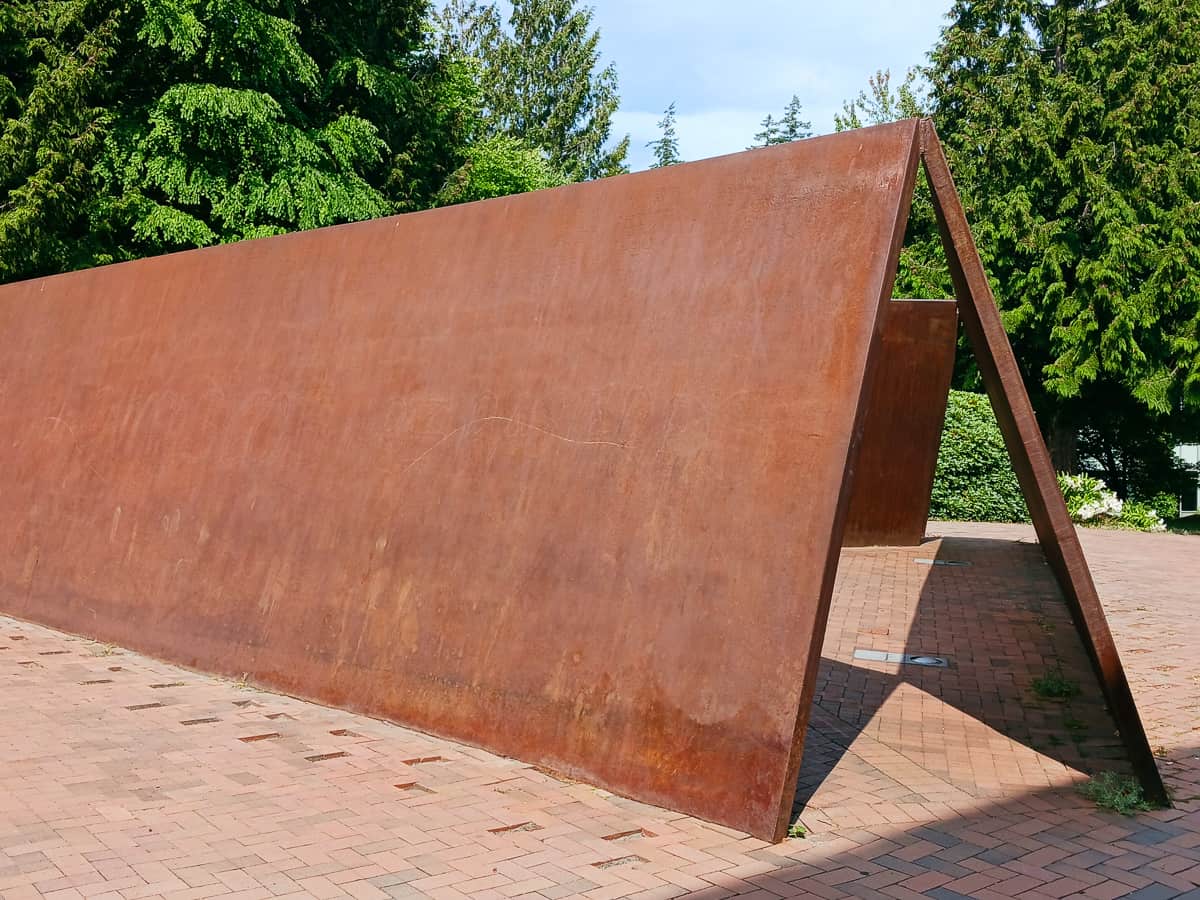
One of the most famous artists represented in the collection is Richard Serra, who created the sculpture “Wright’s Triangle” specifically for the university. It sits on a slight slope near the Western Gallery and was created specifically for the university

Like many of the larger sculptures on campus, the viewer is able to walk into and under the work. Once within, you can look through any of the portholes at the sky. “Skyviewing Sculpture” by Isamu Noguchi.
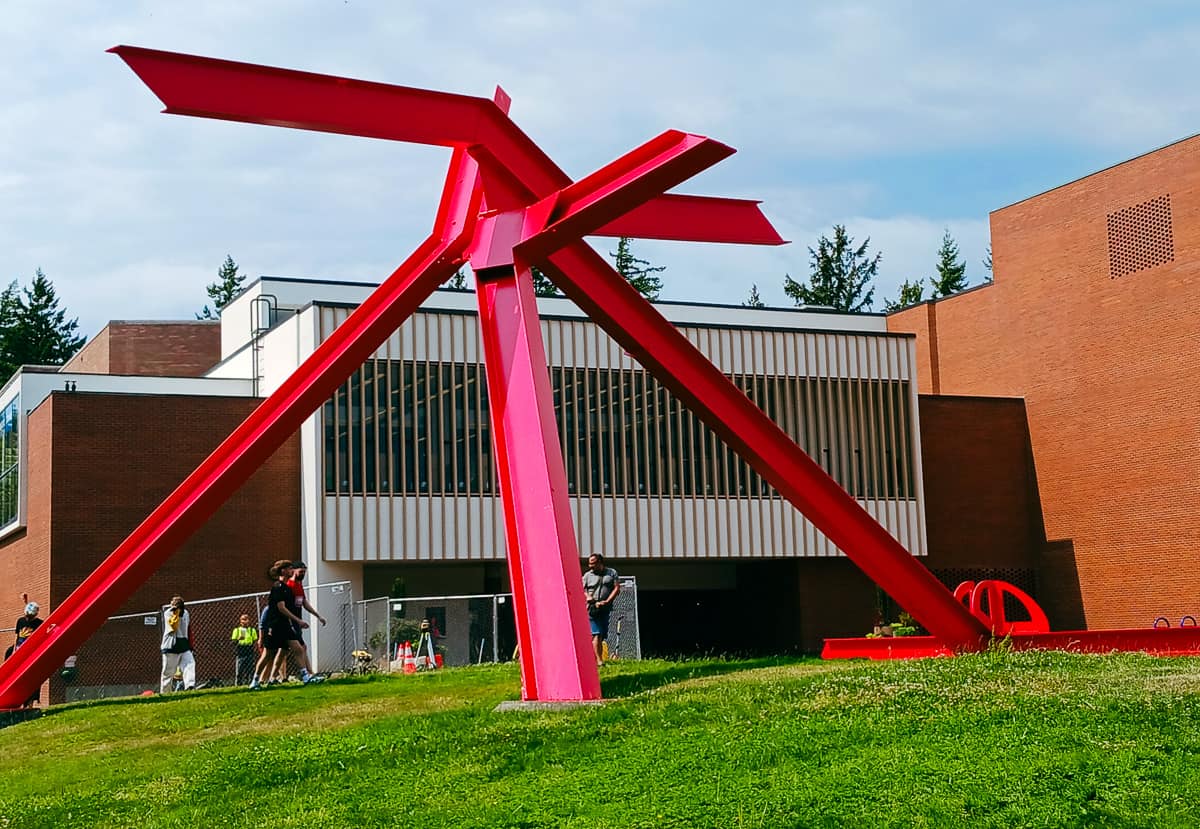
“For Handel” is a highly recognizable installation and sits centrally located between the Performing Arts Center and the student center (Viking Union). Mark di Suvero.
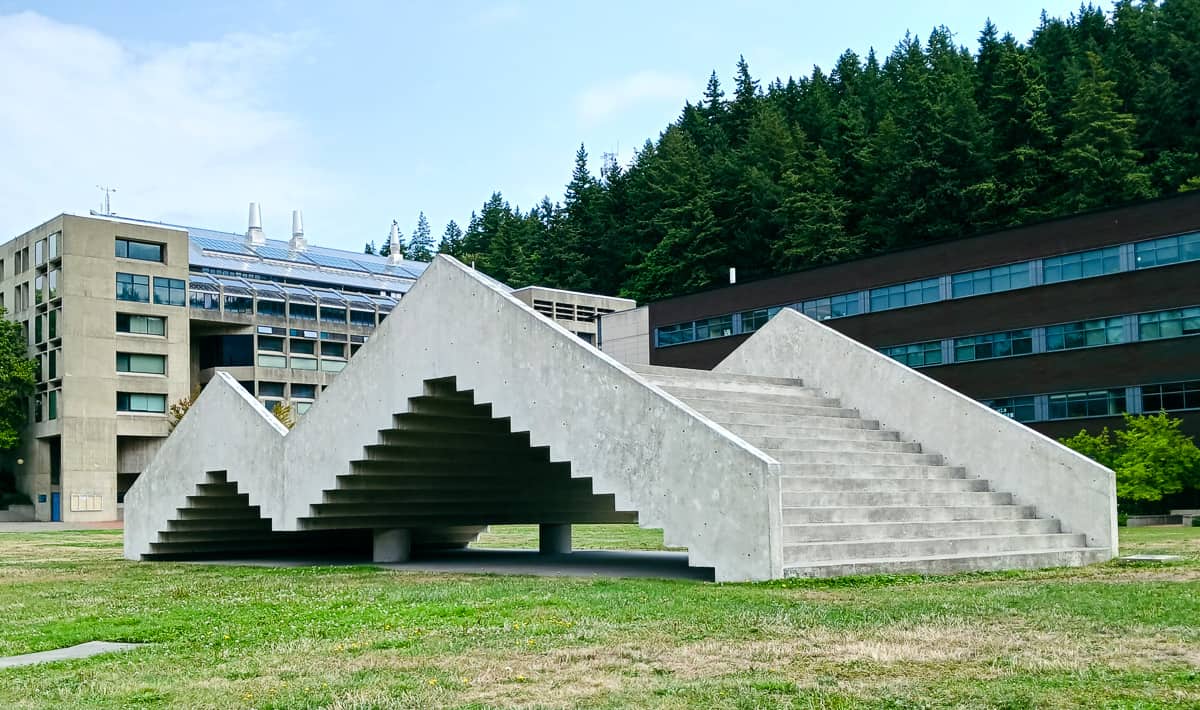
“Stadium Piece” by Bruce Nauman is another distinctive installation. When I was a WWU student, this and Stone Enclosure were in a large field. While campus growth is inevitable, it was sad to see new buildings encroaching on these sculptures and in some ways lessening their grandeur by changing their setting.
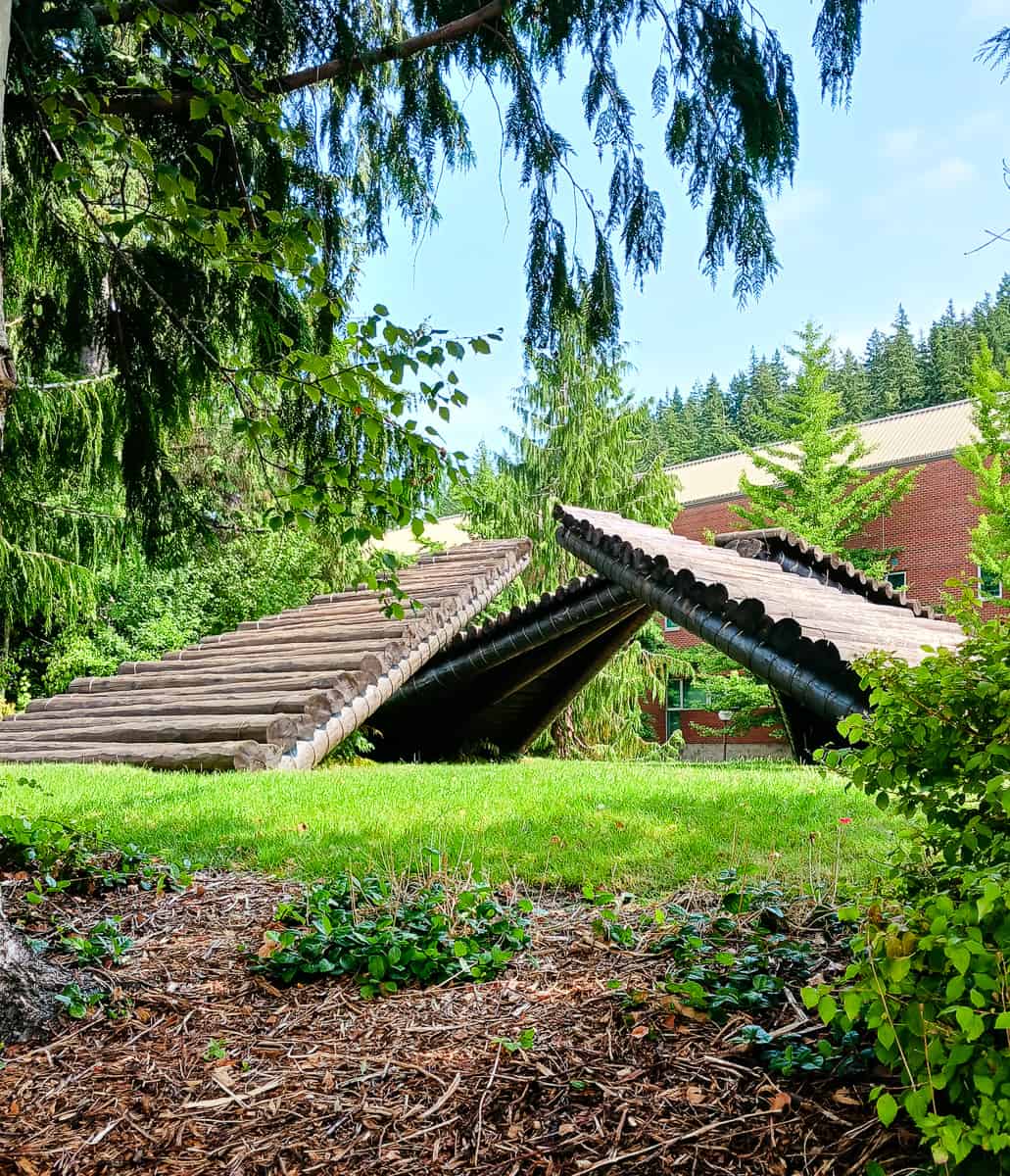
“Log Ramps” by Lloyd Hamrol. Tucked amongst the vegetation, this one strikes me as particularly Northwest. Its setting, the use of timber, and a shape evoking a First Nations lodging.
Other Sculptures
Additional Resources
The Western Gallery Sculpture Collection website provides a wealth of information about the sculptures and their artists. You can view images of the sculptures, read about their history and significance, and learn about the artists who created them. The website also includes information about upcoming exhibitions and events at the Western Gallery.
Whether you are a student, an art enthusiast, or simply someone who appreciates the beauty of outdoor sculpture, the resources available at Western Washington University can help you make the most of your visit. If you are a homeschool parent, consider visiting as a field trip.
Other things to Do on Campus
If you’re interested in exploring more than just the outdoor sculptures on the Western Washington University campus, there are a few options to consider.
Indoor Sculptures
While the outdoor sculpture collection is the main attraction, there are also several indoor sculptures that are publicly viewable when campus buildings are open.
The Western Gallery houses and impressively stunning collection of works, especially considering that this is a regional public university in a town of 90,000.
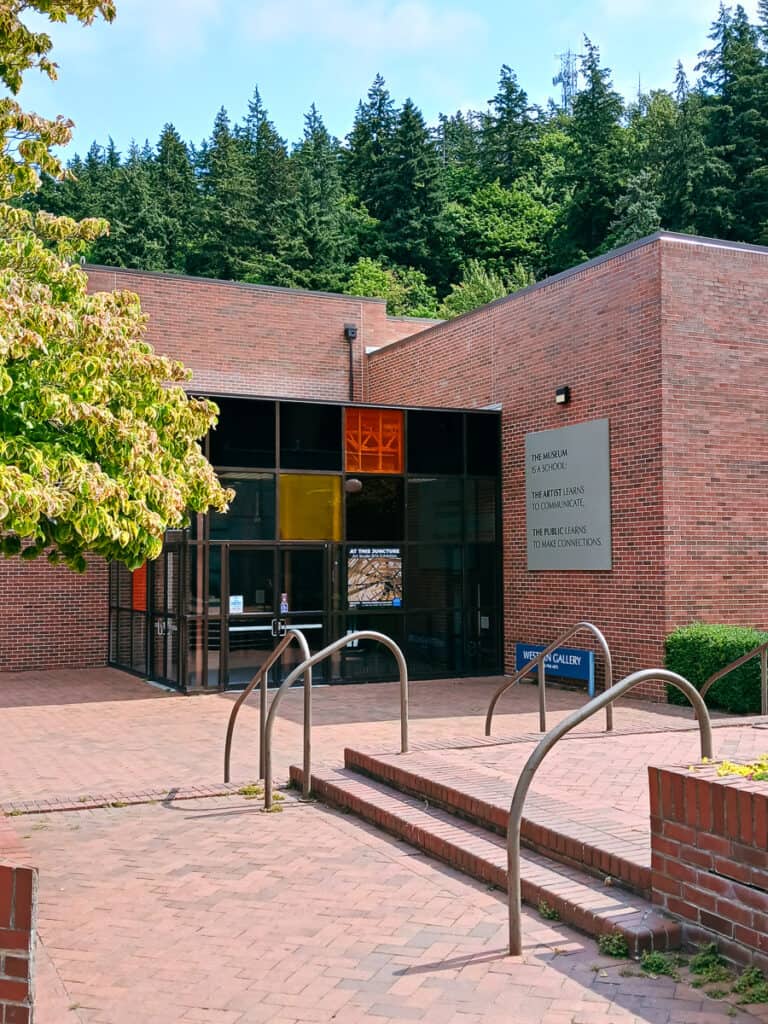
The collection includes:
- Leese/Boylan Collection: American and European prints, drawings, and paintings from modernist and contemporary artists.
- Prints and Drawing Collections: Works representing twentieth-century Modernism.
- Mary Randlett Collection: Portraits of Northwest artists and thinkers, plus nature photographs.
- Works on Paper: American Art 1945 – 1975: 97 works by 48 artists in the era.
- Helen Loggie Archive: Drawings and etchings of Washington State’s flora and fauna.
- Chair Collection: 20th-century furniture by international designers.
- Safeco Collection: Varied media works by Northwest artists.
Artists almost anyone will recognize include: Willem de Kooning, Jasper Johns, Roy Lichtenstein, Jackson Pollock, Andy Warhol, Georges Braque, Wassily Kandinsky, Paul Klee, Frank Gehry, Marc Chagall, Salvador Dali, Edouard Manet, and many more.
Performing Arts Center
Visual art isn’t the only thing going on campus, the Performing Arts Center plays host to a variety of musical and dance performances. Music in the PAC tends to be classical or jazz (Chuck Israels was a professor here for over 20 years before retiring).
Other Outdoor Art in Bellingham
- The campuses of Whatcom Community College and Bellingham Technical College both have a small collection of outdoor sculptures.
- The Fairhaven district is dotted with life-sized bronze figures sitting on benches. Perfect for a selfie.
- Big Rock Garden Park has over 30 sculptures set amongst trees, rhododendrons and azaleas.
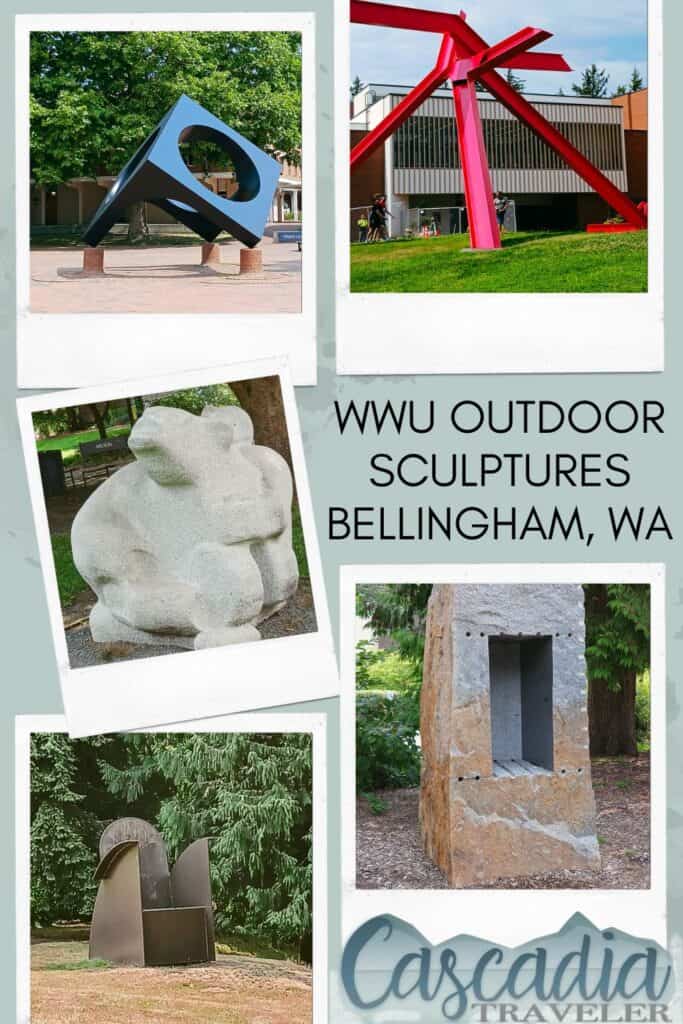
Frequently Asked Questions
Where can I find a map of the outdoor sculptures at Western Washington University?
You can find a map of the outdoor sculptures at Western Washington University on the Western Gallery website. The map includes the location of each sculpture but even then, some of these are a little hard to find. I recommend printing it out–if you just have it downloaded on your phone you are going to be doing a lot of zooming and panning to find each piece and then figure out what it is.
What is the history behind the outdoor sculptures at Western Washington University?
The outdoor sculpture collection at Western Washington University has been growing since the 1960s. The collection features sculptures from various artists and includes a diverse range of styles and mediums.
The sculptures were selected to enhance the beauty of the campus and provide an opportunity for students and visitors to engage with art.
Can I take photos of the outdoor sculptures at Western Washington University?
Yes, you are welcome to take photos of the outdoor sculptures at Western Washington University.
Are there any events or exhibitions at WWU?
Yes, the Western Gallery hosts various exhibitions throughout the year, in addition to its permanent collections.
What’s the Best Time to Visit?
Anytime of year is great, but the grounds will be at their peak April to October. The photos in this post were taken in early August.
How do I get to Western Washington University?
Whatcom Transit Authority services WWU throughout the day. Route 197 and 108 circle through campus. Both originate at the downtown bus terminal on Railroad Ave, where there is street parking (pay parking during the daytime).
Take a cab or ride share. Red Cab Taxi is one of the more well reviewed companies locally.
Drive. Parking is limited when classes are in session. You can download a parking map here, or stop in at the visitors center at the corner of Bill McDonald Parkway and 21st Street. Consider visiting on a weekend or during the summer when things are quieter.
From I-5 northbound, take exit 252 Samish Way/WWU. Turn left onto S. Samish way. At the light turn left on S. Samish way (not a typo) and cross over the freeway. Turn left onto Bill McDonald Parkway. Follow this up to the traffic light at 21st. The visitors center is on your right.
From I-5 southbound, also take exit 252 Samish Way/WWU. Turn right on S. Samish way and immediately turn left at the next intersection onto Bill McDonald Parkway. Follow this up to the traffic light at 21st. The visitors center is on your right.
Walk. If you are in for an extra walk (in addition to walking around campus) it is possible to walk from either Fairhaven or downtown Bellingham.
From downtown Fairhaven, walk up Harris and turn left on 21st. It’s about 1.5 miles and roughly 30 minutes (includes some uphill walking on the the way there).
From Bellingham, walk up (the hill, heading south) on Chestnut or Holly Street to either Garden or High Street. Turn right and head in the direction of the bay. Both Garden and High will take you directly to campus. Garden St. will bring you to your first sculpture, the easy to overlook Bay View Station but you will need to climb the stairs to get to campus. High street will take you right into the heart of campus, with Curve/Diagonal by Robert Maki being your first sculpture. Walking distance is about 1.5 miles (30 minutes).
Bike or E-bike. If you have a bike handy or want to rent one just be forewarned that there is almost no way to get to campus without some sort of climb. If you decide to cycle, tell your thighs I forewarned you.

